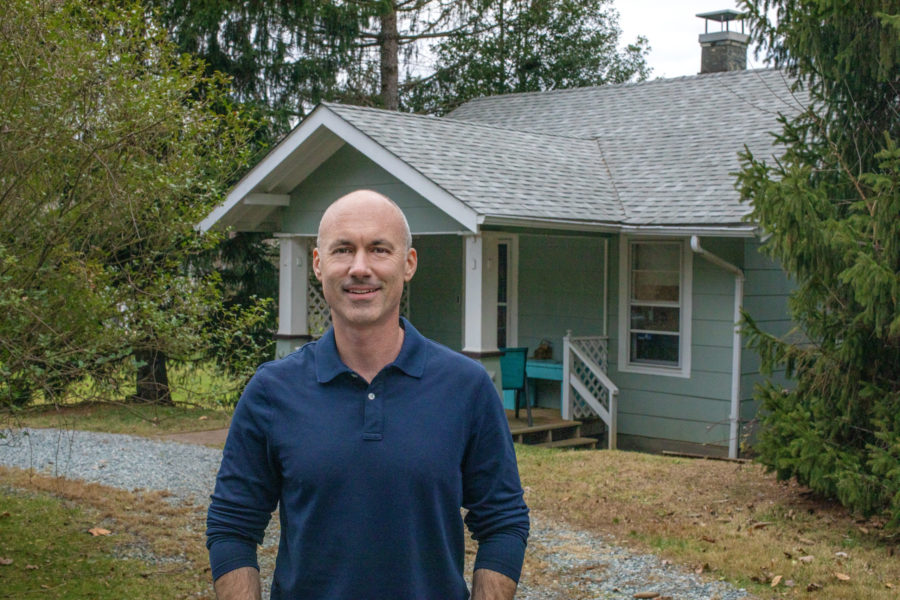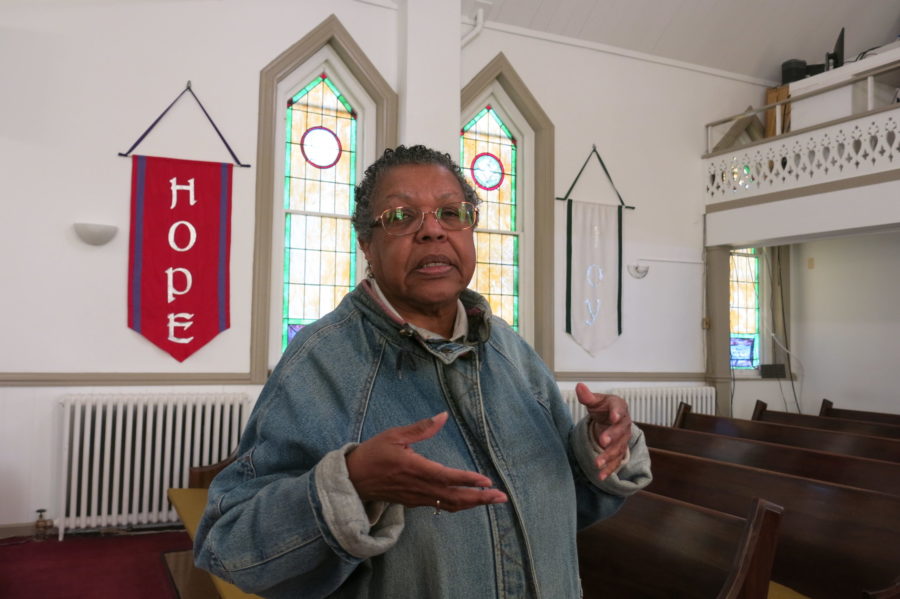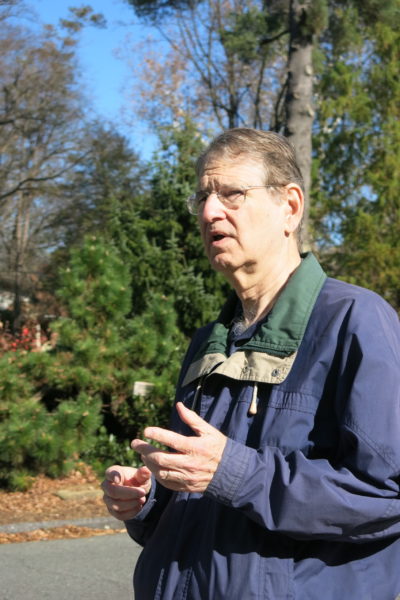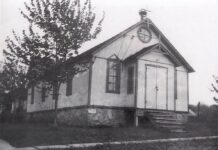
Photo courtesy of Shaun Curtis
Shaun Curtis is crazy about Gaithersburg,
every inch of it. “It’s where I was born and grew up,” he said, with memories of summer camp in the old barn at Summit Hall, and digging for arrowheads on Frederick Road still racing through his head. “It seemed like when I was a kid there were a lot of abandoned houses to sneak into, in the woods and barns.”
“I came home from college [UMBC, 2005] and looked around. Many of the historic buildings were gone,” he said. That vision kicked off a journey to reclaim Gaithersburg history by first posting archival photos, then crafting two picture books, “Gaithersburg: Then & Now” [2010] and “Images of America: Around Gaithersburg” [2020], published by Arcadia Publishing.
Curtis is one in a dedicated group of neighborhood historians writing the history of Montgomery County. Said Matt Logan, executive director of Montgomery History, “Their stories powerfully connect us to where we live, to other people, reinforcing a sense of place.”
One in three residents was born in another country, Logan said, and is now adding “new chapters to our collective memory.”
Curtis started his hyperlocal history project in City Hall, with a computer and a scanner. He knocked on doors, wrote letters by hand, blasted emails, stopped elderly in their tracks and cross-checked people and places online. In this way he amassed hundreds of images, captioned and cataloged them, then matched them by type — whether a house, a store, a farm, a road, a railroad track or a mill — with its 21st century equivalent.
By his own admission, his drives around town can be a bit surreal. “It is like a time machine for me. I can visualize how it might have been 100 to 200 years ago,” he said.
“People would rely on the general store, or the churches, or train station and gather there.”His insatiable curiosity (and a good tip) led him to a nursing home in Frederick, and Carol Mills, whose family was the first owner of his Sears catalog home built 1921. A Mills family photo backs up the claim.
It’s in the book.
So is Rabbit Farm on Clopper Road, owned by Charles Herman Rabbit, a farmer and cattle dealer who hid $700,000 in silver coins in his cellar. The coins were found after his death in 1972. “People with metal detectors come around, even today where it’s just a housing subdivision,” Curtis said. The farm is now a subdivision.
Among his other favorites: Clopper Mill, where a conspirator in the Lincoln assassination spent the night in an escape into Montgomery County; Pleasant View Church and Quince Orchard Colored School, which served one of the largest groups of Black children in the county; and Belward Farm, the last remaining farmland in Gaithersburg between Darnestown and Rockville was sold to Johns Hopkins University for $5 million in 1989. The 1891 farm house is still standing.
Curtis says his pile of pictures continues to grow. Whether it’s another book or not, he can’t say, but as a skilled multimedia producer for Universal Service Administration Company he certainly knows a good story when he sees one, as do his readers.
“I’ve gotten many emails, just saying ‘thank you, I had no clue there was this much history here.’”

Photo by Rosanne Skirble
For love of church, and its stained glass in blessed memory
Chiquita Sorrels discovered the Jerusalem Mt. Pleasant Church and Parsonage in Rockville on a Sunday morning. It was 1996, and she wasn’t heading to church. She was out on other business nearby and just happened to find a great parking place.
“And, I wondered, what was [this white stucco] church doing in the middle of downtown Rockville around all these law offices?” she said. “The church was African-American Methodist, and growing up in Chester County, Pennsylvania, so was my family.”
Within a year, Sorrels was a church member, driving from her home in Aspen Hill and eventually taking on more and more church duties. These days she serves as church treasurer, and communications chair, lends support to the media ministry, while also acting as church historian. This is a perfect fit for a woman with a degree in library science, and who teaches computer classes.
According to church records the [then] Rockville M.E. Church was erected in 1858.
“It was a church with both races, but not integrated. [Blacks] had to sit in the upstairs gallery and [could] only take communion after whites had been served and left the church,” Sorrels said.
By the end of the Civil War, the church was turned over to its Black members and has remained a predominately African-American congregation ever since, surviving mergers and name changes.
“It’s amazing to know the history. It [gives me] a sense of place, a sense of community, a sense of belonging,” Sorrels said, explaining that the church basement was turned into a school house for Black children when their school burned down in 1919, and that it hosted graduation ceremonies for Rockville’s Colored School well into the 1950s.
Other important milestones: The Montgomery Chapter of the NAACP was founded here in 1937, and Hebron House and Print Shop, a longstanding successful Black-owned business operated in an adjacent building for more than 50 years. Now the church has its administrative offices there.
On a tour through the church, Sorrels says what gives her a special sense of awe is the sanctuary itself, its humble wooden pews surrounded by 16 tall and narrow stain glass memorial windows that filter rainbows of color throughout the church on a sunny day.
“We’ve researched every organization, every person mentioned in the windows,” Sorrels says of the many layered history of those who prayed here.
In the windows are lilies, a rose, a dove with an olive branch, a star of David, a Bible and the Ten Commandments. A fish honors the Grand United Order of Galilean Fisherman, a Black fraternal organization that provided it members with sick and death benefits. There’s also an empty circle, a symbol of eternity that celebrates the Rev. Daniel Wheeler, the congregation’s first African-American pastor.
While no longer located in an African-American neighborhood, “We’re still a vibrant, living church,” she said. “We have a scholarship fund, a community pantry and work with [homeless] shelters.”
She wants people to visit and to know its history. “It deserves to be here and deserves to stay here,” she said.

Photo by Rosanne Skirble
Silver Spring Centennial Suburb
Traveling north from downtown Silver Spring, you might miss Woodside Park, a walkable wooded community with deep back yards tucked into the side streets. The Montgomery County Historic Planning Staff of the Maryland-National Capitol Park and Planning Commission once called for its recognition as an historic district, praising the 1920s subdivision as a suburban ideal.
“What’s remarkable is how little it has changed,” said Bob Oshel, who has lived in Woodside Park since 1975. “What we retain is really the look and the feel of the neighborhood. Those streets that were designed to follow the stream valley and hills are still that way today,” he said.
Oshel, now retired, worked as the research director for the National Practitioner Data Bank for the Department of Health and Human Services. His interest in history came with a project to revise a Woodside Park historic pamphlet. That volunteer job evolved into a 320-page book called “Home Sites of Distinction: The History of Woodside Park” published in time to celebrate the Park’s 75th anniversary in 1998.
Now, 25 years later coinciding with the centennial, Oshel has released “Woodside Park: Home Sites of Distinction for 100 Years.” Setting the context for neighborhood history he has written a chapter on the history of Silver Spring, with notes on every house and accompanying archival photos, maps, newspaper clips, sales brochures and advertisements.
Reading about your home reveals tantalizing details, as well as alarming surprises, like racial covenants, which Oshel says were common from the 1910s to the 1940s in the District and lower Montgomery County, and are now discredited and illegal. Deeds issued from the Woodside Development Corporation read: “For purposes of sanitation and health” [no owner] “will sell or lease the said land to anyone of a race whose death rate is a higher than the white race.”
Woodside Park’s origin story began in 1882 when Crosby S. Noyes, editor and publisher of the Evening Star, purchased the land for a farm estate. “He built a mansion, planted shrubs and trees, and constructed a 100-foot water tower as part of the farm’s extensive water system.” Oshel said.
After Noyes died in 1908, Alton Farm, as it was known, went to his heirs. In 1922, the 184-acre estate was sold to the Woodside Development Corporation for $160,000 or $2.8 million in today’s dollars. “There were as yet no streets. In fact, the development plan was not even submitted for approval until January 1923 after the first lots were sold,” Oshel said.
The Corporation advertised one-acre plots. Owners hired their own builders, which explains why the neighborhood grew with many architectural styles.Half of its 599 single-family homes were built before World War II. The 42 townhouses are a more recent addition to this tight-knit friendly community, where residents take advantage of amenities in urban downtown Silver Spring like the American Film Institute, many restaurants, a farmers market, a public library, an outdoor ice-skating rink, and concerts, ethnic festivals and other public events on Veterans Plaza, just minutes from their homes.
Neighbors meet jogging, dog-walking, at food trucks and at the annual Octoberfest and June picnics that take place along the wide streets and in the bordering Fairview Road Urban Park. They also consider issues like crime, food insecurity and housing, in the regular meetings hosted by the Woodside Park Civic Association.
Oshel reminds his neighbors of their history with his monthly contribution in the VO!CE newsletter called Woodside Park from A-Z. The alphabetic journey in a recent L month featured Largest (original) lot, Last (two) lots sold and Lecture Series, the latter with photographs promoting the event in the Washington Post in 1923.
Also updated for this centennial year is “The Woodside Park Walking Tour: Architecture, History, Notable Trees,” a 52-page illustrated booklet written by Oshel and tree experts and neighbors RG Steinman, and John Parish. The authors promise several walking tours.
What does Oshel want outsiders to know about Woodside Park who might tag along? “That it is an amazingly well-preserved example of an early 20th century suburban neighborhood, and that we’ve been a very welcoming community for many years.”
Rosanne Skirble is a freelancer who lives in Woodside Park in Silver Spring.




